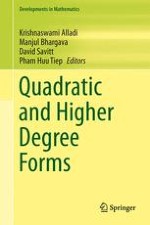2013 | OriginalPaper | Chapter
Weighted Generating Functions for Type II Lattices and Codes
Authors : Noam D. Elkies, Scott Duke Kominers
Published in: Quadratic and Higher Degree Forms
Publisher: Springer New York
Activate our intelligent search to find suitable subject content or patents.
Select sections of text to find matching patents with Artificial Intelligence. powered by
Select sections of text to find additional relevant content using AI-assisted search. powered by
